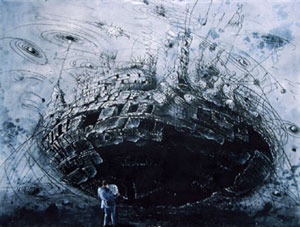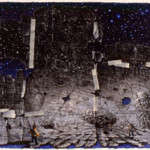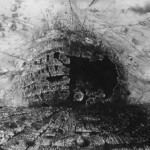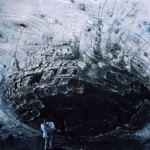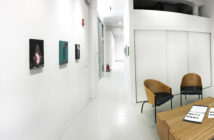As many reviews on Gerry Bergstein’s current work have noted, there is something new to see here: small story book figures-- “witnesses” inserted into Bergstein’s cataclysmic landscapes. I Love Architecture #3 shows a red-shirted man, holding a hammer as long as his thigh, and a girl with a purple skirt; I Love Architecture #4 offers a blue suited man in a casual contraposto; in Men, the hammer-toting man is joined by two other work men (all somehow reminiscent of Rivera’s monumental new-socialist worker) and I Love Architecture #1 includes a small girl in a pink dress, staring up at an erupting and massive tower. Post-apocalyptic in the proper sense, these landscapes reach back as intensely as they project forward, invoking Brueghel’s Tower of Babel-- a familiar trope for those familiar with Bergstein’s work-- while they seem to presage an impending doom. Something that has not yet quite totally happened, not yet affected our story-book witnesses...
Bergstein’s other characteristic trope, the trompe l’oeil, is also present. Men and I Love Architecture #1 both articulate Bergstein’s familiar faux-collage, though with the following difference: In Men it is visible as tape holding together a torn and decayed visual field set against a starry sky, like the letter of a loved one ripped in anger and now frantically taped back together (as if the violence could be re-made or undone). I Love Architecture #1 seems, at first glance, to be more “whole”, its dark palate only momentarily offset by the little pink girl (evocative of something between Trixie Belden and Dr. Seuss). Here, the ripped depiction of the tower, the marker of hubris, is set against a sky of its own colour. We are offered the collage remnant of a figured world ambiguously resting between the representational logic of a ripped painting and the representational logic of the painting itself.
Let me return to one of Bergstein’s figures for a moment: the contraposto blue suited man of I Love Architecture #4. This figure, in a one-step mise-en-abyme, is holding in his hands his own fragmented, decaying sheet of paper, mirroring the one at which we are looking. It strikes me that there is something important about this figure, something that we can extrapolate into the others. Nicely suited, he is our only “non-workman” adult. Back turned towards us, he stares somewhere between the ominous mass in front of him and a torn sheet in his hands. The mediation of the map as well as his casual stance marks a distance, a dis-attachment from the chaos before him. This man is, like us, uniquely in the position of the viewer-- a position only heightened as I glance at my reflection in the framed glass, holding my writing pad at roughly the same angle as the blue suited man holds his map-- assured of a vertical, optical, mastery over the horizontal wasteland.
I could happily dwell on these narrative tropes of Bergstein’s: the tower and its Babylonian antecedents, the elliptical sphere and its Renaissance allusions (Euler). Instead, I would like to pause on the multiple scratchings that form the architectural, technological and anthropomorphic explosion of line that figures throughout these works. While Bergstein’s materiality is often mentioned (as etching, incision, digging and scratching), this mention is usually departed from immediately, mentioned only to move on and focus on his historically and playfully inflected post-apocalism or reflexive trompe l’oeil plays. I find myself, however, less interested in these Bergsteinian tropes than in thinking about the materiality of the mark-making that inflects the visual fields of his painting, unifying each landscape.
In I Love Architecture #1, for example, narrative delineation is pointedly muddled by graffito markings that permeate the visual field, scraped into the density of the paint in a wash of scribbles that transgress the boundary so firmly maintained in Men through its differentiated azure sky. These graffito marks are gouged into the very fabric of the scene, and range from Twombly –esque anthopomorphism and cypher-like scrawls to aggressively descriptive volumetric lines. The tension that this highlights is one between the illusionistic narrativity of the works and their visceral materiality.
It is the temporality of this materiality that is, finally, what indexically marks the loss that the paintings narratively frame.
I will leave you with Rosalind Krauss who, in chapter six of “the Optical Unconscious” (her seminal re-positioning of Pollock within the cannon of modernist production), articulates this strategy of mark-making with a turn to Derrida’s structure of the arche-trace and logic of erasure. Trace, within Derrida’s text, constitutes a prior plenitude. For Derrida, in short, the trace functions as index, a holder of the enigmatic message. In Bergstein’s work this is articulated somewhere between the indexicality of the graffito mark, the violence of that trace, and its retroactive imperative. In Krauss’ words:
“The graffitist goes up to a wall. He makes a mark. We could say that he makes it to register his presence, to intervene in the space of another in order to strike against it with his declaration, “I am here.” But we would be wrong to say this. Insofar as his declaration is a mark, it is inevitably structured by the moment after its making...the future moment that makes of its making nothing else than a past, a past that reads “I was here,” “Kilroy was here.” Thus even at the time the marker strikes, he strikes in a tense that is over; entering the scene as a criminal, he understands that the mark he makes can only take the form of a clue. He delivers his mark over to a future that will be carried on without his presence, and in so doing his mark cuts his presence away from himself dividing from within into a before and an after...the index’s violence is not, then, just a consequence of its being (a) residue...but is instead a condition of the structure of the marker’s having been cut away from himself...voided of his own presence, leaving only his mark. “Kilroy was here,” he writes in a present already invaded by the future.”
Links:
Howard Yezerski gallery
"Gerry Bergstein: New Paintings" is on view through May 4th at Howard Yezerski Gallery.
All images are courtesy of the artist and Howard Yezerski Gallery.
Natalie Loveless is a regular contributor to Big, Red & Shiny.

